From beginning to end, from Brooklyn through Queens and into Nassau County, Linden Boulevard is one of NYC’s lengthiest thoroughfares, running a total of 12.3 miles. However it’s also unique among NYC’s longest streets. It’s made up of varying widths, from a one-lane trickle to a 10-lane superbehemoth to a regular two-lane street. Alone among NYC’s major named streets, it roars for miles, comes to a stop, begins again in fits and starts before roaring to a close. Though I don’t drive at all, I’ve always been fascinated with this unique thoroughfare. Through the magic of Google Street View, I have been able to survey it beginning to end without taking the better part of a day it would entail to walk its entire length. (I’ve done screen shots and left in the Google tags on the photos.)
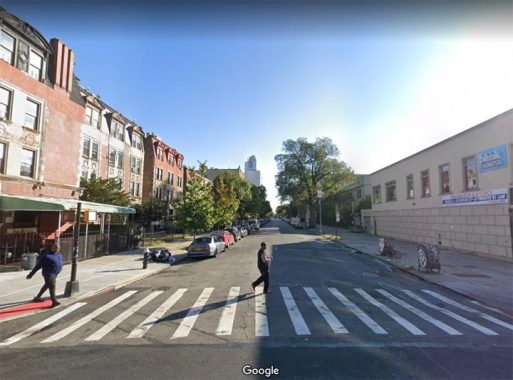
My first encounter with Linden Boulevard was through bus rides one or the other parent would take with me when I was a kid. One of them involved taking the B35 bus which runs, then as now, down Church Avenue. We would get off at Flatbush Avenue and walk around, checking out the shops (a particular favorite was a huge candy store at Flatbush and Caton, long gone). I first noticed Linden Boulevard then, and later as a Cub Scout we would periodically take bus trips out to some location in Queens or Long Island (for me, the best part of the trips was securing a window seat, and looking out the window at the lampposts). For some reason one day the driver took Linden Boulevard and I was utterly absorbed at how it widened and lengthened the further east you went on it…
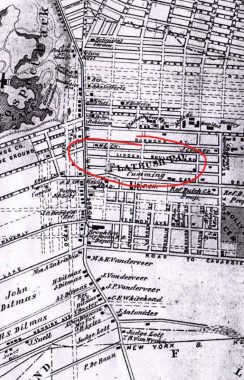
Here’s a map of the center of Flatbush in 1873. Until the 1890s Flatbush was a separate town in Kings County, with its center at the Dutch Reformed Church at Flatbush and Church Avenues. Gradually the City of Brooklyn absorbed the Kings County towns, and in 1897 Brooklyn narrowly voted to join Greater New York City, which it did, on January 1, 1898. Linden trees abounded in the area, hence the name.
On this map the overall street grid still holds true, but most of the roads have been renamed (East Broadway to Church Avenue, for example). Not so Linden Boulevard, which I have circled in red. In 1873 it was known as a Boulevard, but it became an Avenue for several decades, finally settling on Boulevard again in the 1920s.
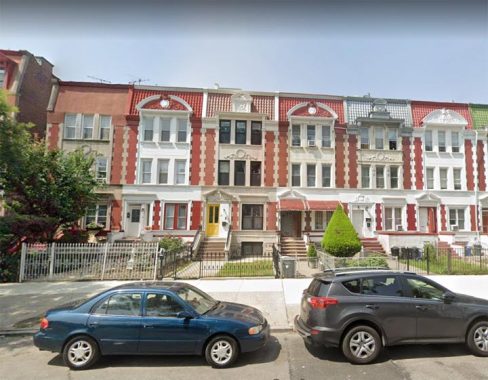
A sampler of attached multifamily buildings on Linden Boulevard between Flatbush and Bedford Avenues. For one block, Linden Boulevard is one-way eastbound.

Looking westbound at Linden Blvd., Bedford Avenue and Caton Avenue. Here, NYS Route 27 joins Linden Boulevard and will be coterminous with it as far east as Conduit Boulevard. Route 27 runs west from here along Caton Avenue, East 5th Street, and the Prospect Expressway as far as I-278 at the Gowanus Expressway.
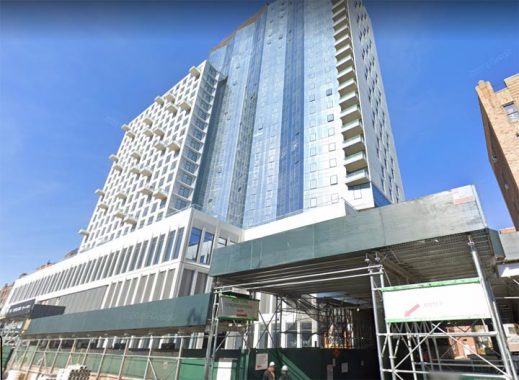
123 Linden Boulevard, west of Rogers Avenue, is a 26-story luxury residential building, under construction in 2020, that towers over its neighbors. It stands on the former footprint of the New York Congregational Home for the Aged.
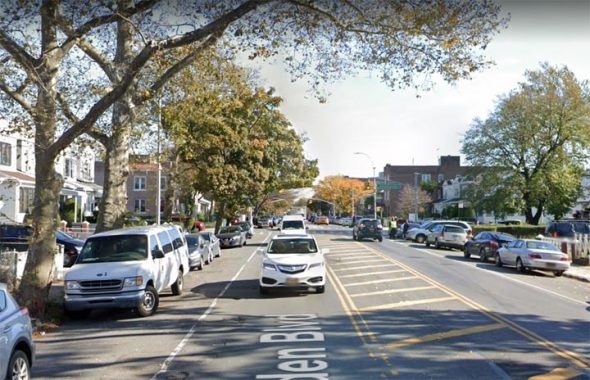
Linden Boulevard at East 35th Street. Though the road was originally laid out to a lengthy width (100 feet) in Flatbush and East Flatbush, the city has restricted it to two lanes by painting a wide center median.
The center was a grassy median at one time but those have since been eliminated.
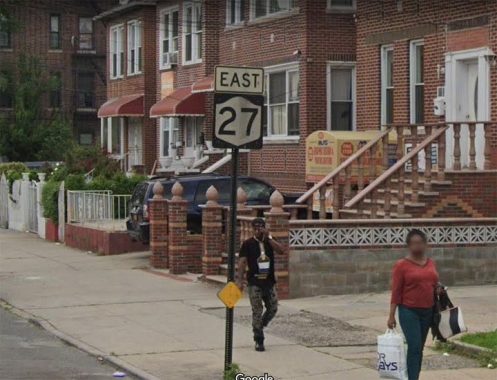
There are reminders, here and there, that Linden Boulevard is coterminous with NYS Route 27. To this day, an east-west expressway has never been built across Brooklyn, and the window of opportunity for that is more or less closed. The Belt Parkway, far to Linden Boulevard’s south, remains the sole express east-west auto route in Brooklyn south of the BQE, and it is closed to trucks — leaving Linden Boulevard as the main east-west truck route in these parts.
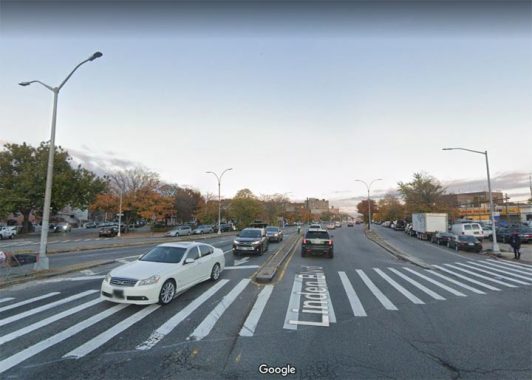
The game changes for Linden Boulevard where it meets Kings Highway and Remsen Avenue, where its width changes to 170 feet across, and it gains multiple lanes of traffic, giving it a total of 10.
The online history is sketchy about this alteration. This much I know:
In the 1920s, at the dawn of the automobile age and before Robert Moses built the Belt Parkway, there was a perceived need for a better traffic flow in Brooklyn. Kings Highway and Linden Boulevard were selected for expansion, and construction, into multi-lane boulevards. Prior to the 1920s, Kings Highway had been a rutted farm road running generally northeast from Gravesend to Brownsville, where it met the Hunterfly and New Lots roads, other colonial-era highways that have largely disappeared. Linden Boulevard, for its part, didn’t exist east of East Flatbush…
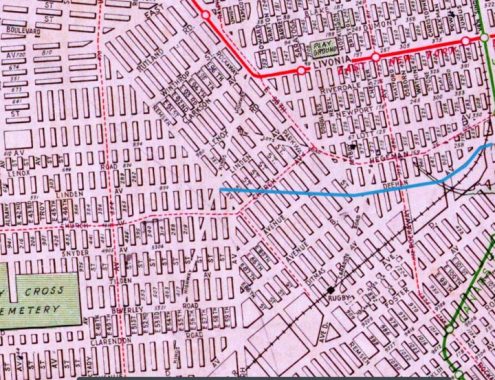
I have excerpted this very early Hagstrom map from 1922. That year, Linden Boulevard was still known as Linden Avenue and ran east, then jogged northeast, to its ending at East 98th Street. Many of the streets depicted here were “paper streets” that were only built at a later date.
Traffic engineers decided to extend Linden Avenue east and make it into a wide boulevard. I have traced its new path on this map in blue. The new Linden Boulevard would scythe through the NW-SE traffic grid and then jog temporarily northeast to avoid the curve of the Long Island Railroad, which would ultimately be bridged over it. In East New York, Linden Boulevard would assume the routes of Hegeman and Vienna Avenues (later renamed Lorrain and then Loring).
While Kings Highway’s widening was largely completed by 1929, Linden Boulevard lagged behind. You can see this by looking at various plates on the Belcher Hyde Brooklyn Desk Atlas, which shows Linden Boulevard mapped, but not yet built.
In the 1920s, traffic engineers were not yet ready to design limited-access highways and parkways in open cuts and elevated sections, likely because overall traffic was lower than today. So, at-grade highways such as Kings Highway, Linden Boulevard, and Roosevelt Boulevard in Philadelphia appeared.
In Comments, see photos of the new widened Linden Boulevard in 1934. Twin Type F lamps were originally employed for illumination.
But Linden Boulevard’s story seems to indicate that even greater glory for it was stymied by the Depression, World War II, and horse racing….
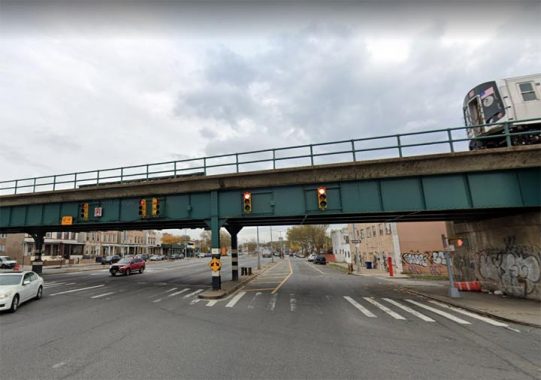
The Canarsie Line subway (L train) crosses Linden Boulevard at Van Sinderen Avenue. The 2, L, 3 and A trains all cross Linden Boulevard at some point, but Linden Boulevard is likely NYC’s longest street without a dedicated subway stop —mainly because much of it didn’t exist when subways and els were built in the early 20th Century.
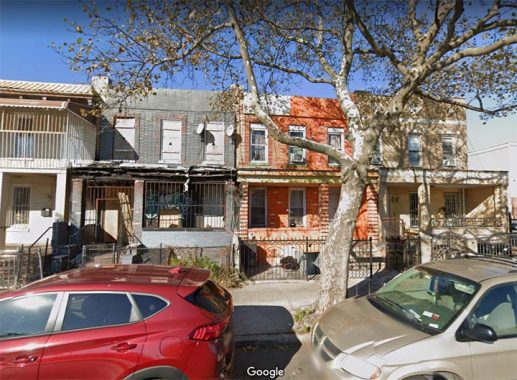
Private homes along Linden Boulevard on the north side, between Snediker and Hinsdale. When these houses were constructed they had been on Hegeman Avenue, but Linden Boulevard assumed part of Hegeman’s route in this location. To this day there are relatively few addresses on the wide section of Linden, and very few residences.
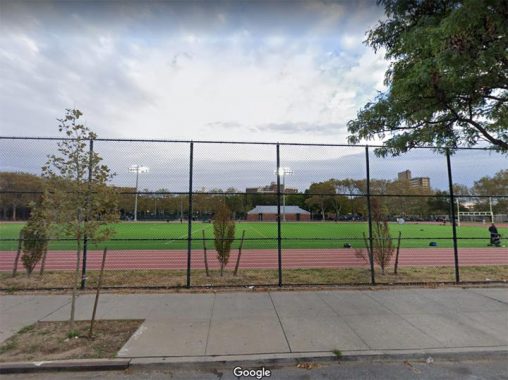
Linden Park. Green spots are few and far between in East New York, and the park, between Vermont and Van Siclen Avenues on the south side of Linden Blvd., partially fills the bill.
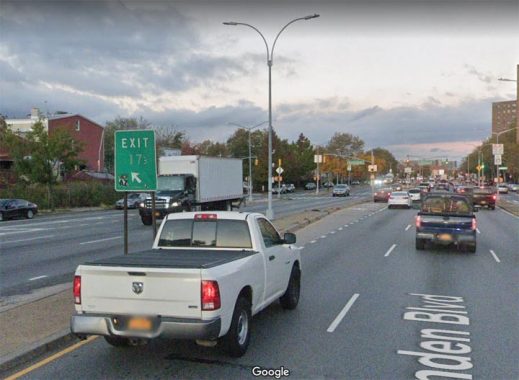
Linden Boulevard became part of NYS Route 27 in 1934, when the state route was extended west (that may be a clue as to what year the Linden Boulevard reconstruction was completed). And, as a NYS Route, it actually has entrances and exits despite it being an at-grade road. However, the NYC Department of Transportation has largely let these entrance and exit designations fall into disuse, and while there are a few older exit signs to be found such as here at Exit 17, they seem to be fading fast and will not be replaced.
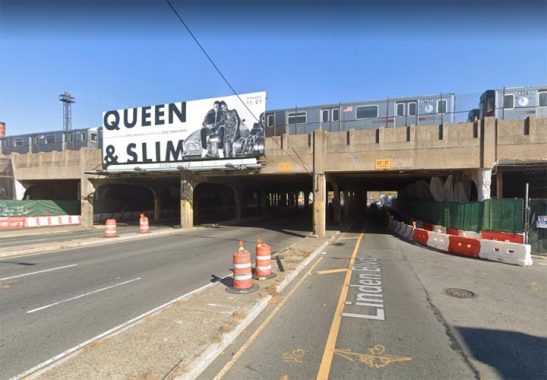
The #3 train passes Linden Boulevard between Elton and Linwood Streets — or rather, the elevated trainyard servicing the #3, whose last stop is at New Lots Avenue. There has been some talk of extending service one stop south to Stanley Avenue using the trackage here, but that’s not likely to happen.

Pink Houses for you and me. The Louis H. Pink Houses were completed in 1957 and named for the chairman of the NYS Housing Board and the official responsible for creating the NYC Housing Authority. Way back in 2005 I was on a ramble through Brownsville and East New York with Mike Epstein, who was at the time running a photoblog called Satan’s Laundromat (the address of the laundromat near where he lived was 666 Fulton Street). When we got to the Pink Houses we were stopped by the cops and asked for ID.
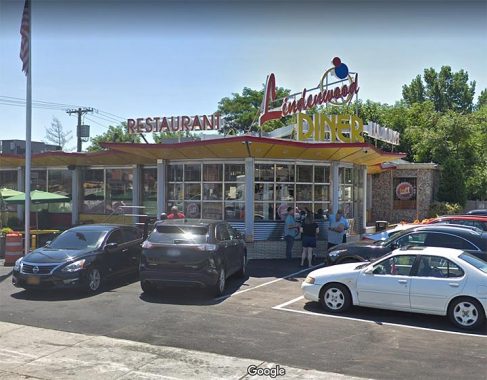
Another diner on my list, the Lindenwood, at Linden Boulevard and Sapphire (78th) at the Brooklyn-Queens line. South of here, you’re in The Hole, a forgotten neighborhood indeed, consisting of mostly unpaved streets with poor drainage; you can get a decent look at it on FNY’s Elderts Lane page.
It’s “exaggerated” modern with a zigzag roofline and amazing neon signage. I’m unsure of the make, but it appears to have been built in the 1960s. As stated this is a busy truck and auto route, with the entrance to Conduit Boulevard, which accesses the Belt Parkway, just to the east. Open for takeout during the 2020 Covid Crisis.
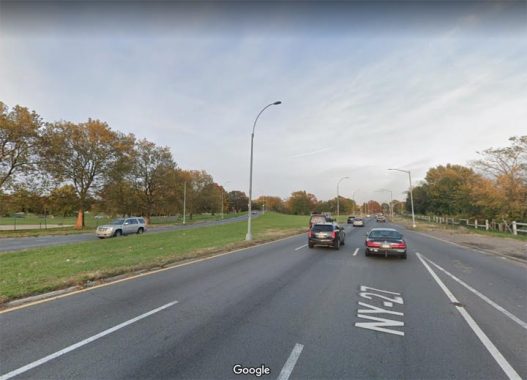
East of the diner Linden Boulevard’s traffic and Route 27 flow into Conduit Boulevard, which upon crossing into Queens becomes North and South Conduit Avenues. And, a bit further east, the Conduits (named for former underground conduits to Ridgewood Reservoir a few miles north of here) become the service roads for the Belt Parkway.
Previously this entire stretch of road was called the Sunrise Highway when it was first constructed in the 1920s. However, Sunrise Highway today begins at the Laurelton Parkway in Queens and runs coterminous with NYS 27 on alternately at-grade and express highway sections along the south shore of Long Island out to the Hamptons.
But the Linden Boulevard story isn’t over: the weird part is just beginning.
In Ozone Park there are actually two stub sections of Linden Boulevard, one at Pitkin Avenue and Sitka Street, and the other on DeSarc Road between Sitka and Cross Bay Boulevard; the stub off DeSarc actually has one or two Linden Boulevard addresses. Then…
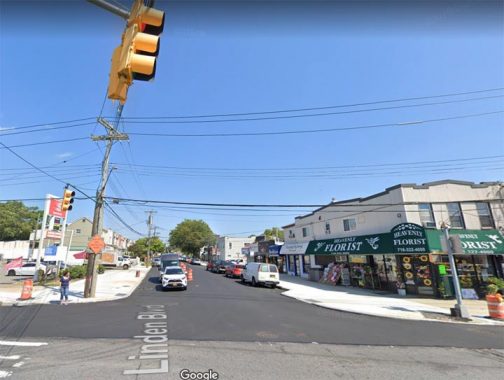
… a continuous section of Linden Boulevard begins in earnest, at Cross Bay Boulevard. What the heck is going on? On this 1922 Hagstrom map of Queens, Linden Boulevard in Ozone Park is marked as “135th Avenue.” This section of Ozone Park is decidedly weird, with a number of diagonal, grid-defying streets that have kept their old names and never been numbered.
As far as I can ascertain, at the same time Linden Boulevard was expanded and attached to the Belt Parkway in the 1920s, there was also a plan to continue that expansion all the way through Queens. To do that, some sections of Linden Boulevard would have to be built, while some of it was to run along pre-mapped or pre-existing streets. But in Ozone Park, things never proceeded past those two stub ends. Since the plan called for a continuous Linden Boulevard all the way out to the Southern State Parkway, the roads were indeed renamed, but apparently the money ran out (the Depression, WWII, or both) you now have a lot of disconnected streets called Linden Boulevard.
All of which is standard in Queens, were groups of disconnected roads are all part of the same numbered avenues and streets!
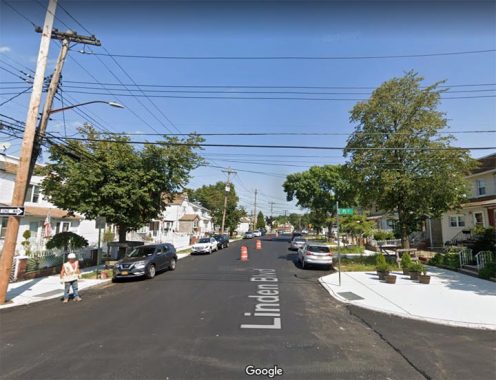
The Ozone Park section of Linden Boulevard (here at 95th Street) runs about one mile between Cross Bay Boulevard and Centreville Street. In 2019 the roadway was repaved and the sidewalks given curb extensions that lessen the distance for pedestrians.

The A train, bound for the Rockaways or mid-Brooklyn or Manhattan, passes above Linden Boulevard. The nearest stop is at Aqueduct Racetrack.

Linden Boulevard, Centreville Street and Peconic Street all come together opposite Aqueduct Racetrack and the Resorts World Casino. Peconic’s name has always perplexed me; it’s a Native American name, and Peconic Bay is nearly 100 miles away at Riverhead, Suffolk County–why would there be a street named for it here?
Mid-20th Century maps show Linden Boulevard running straight through the Aqueduct Racetrack grounds. Were it to do so it would clip the northern stretch of the actual track! Thus this extension never materialized.
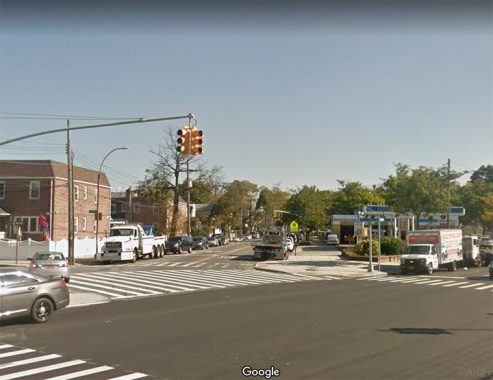
Linden Boulevard resumes again, on the other side of the racetrack, at Rockaway Boulevard and 113th Street, and this time it’s for good: it continues from here uninterrupted to the city line and beyond. However, this wasn’t always Linden Boulevard…
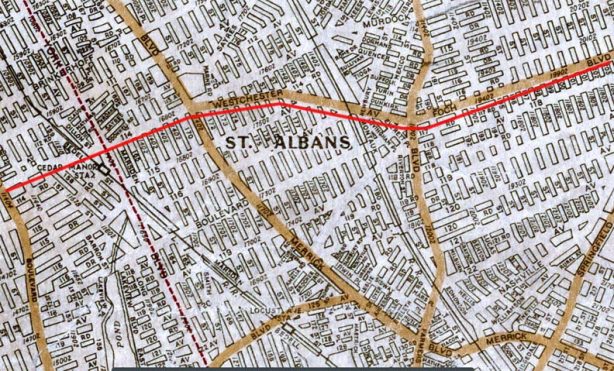
On this 1922 Hagstrom map of Queens, I’ve highlighted the current route of Linden Boulevard in red. That year, Hagstrom tabbed Linden Boulevard as 114th Avenue, Westchester Avenue, and Foch Boulevard. In the probably Mosesian aspiration to extend and widen Linden Boulevard out to meet the Southern State Parkway, at some time after 1922 (I’d say certainly by the 1930s) this entire stretch was renamed Linden Boulevard.
Foch Boulevard’s namesake is Ferdinand Foch, Marshal of France in World War I. In 1919, a new road constructed between South Ozone Park and South Jamaica was designated as Foch Boulevard in honor of the distinguished allied commander. Four out of five boroughs have streets honoring Lafayette, and an avenue in the Bronx for Rochambeau. Foch Boulevard is the only road in New York named after a French World War I commander. The piece that still exists today runs between Rockaway Boulevard and 126th Street a few miles east to Merrick Boulevard.
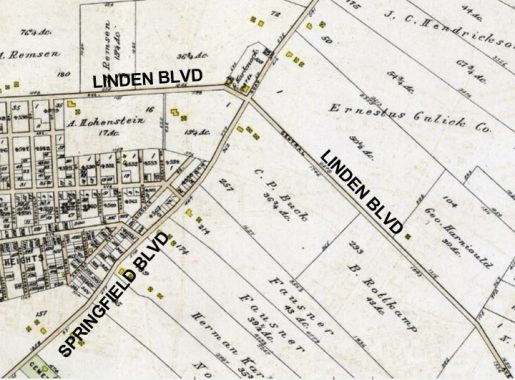
If we go back even further, the present-day stretch of Linden Boulevard was named Central Avenue in 1909. You can see that the present-day street grid was just a mote in the eye of future developers.
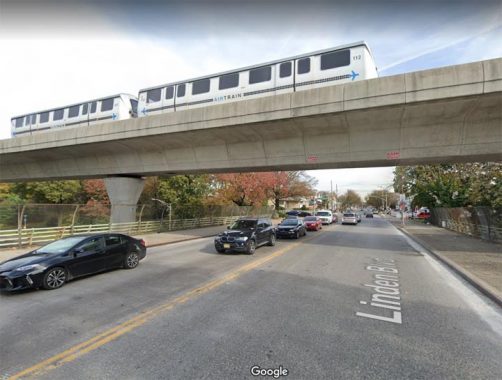
As Linden Boulevard runs above the Van Wyck Expressway, the StreetView camera caught a two-car AirTrain set speeding above the expressway, annoying motorists no end who sometimes have to sit in traffic en route to the airport. The express rail system opened in December 2003.
When you think of jazz, you think of New Orleans, Chicago, Harlem, or even Greenwich Village. Queens doesn’t come immediately to mind. Yet, some of the greatest jazz and big band names were either born, spent a great deal of their lives, or died in Queens. In the mid-20th Century, some of the biggest names in jazz and pop, including Count Basie, Ella Fitzgerald, Lena Horne, Milt Hinton, Fats Waller, James Brown, and baseball’s Jackie Robinson flocked to buy the trim Tudors in Addisleigh Park in southern St. Albans. Brown’s home in the 1960s, at Linden Boulevard and 175th Street, is shown here.
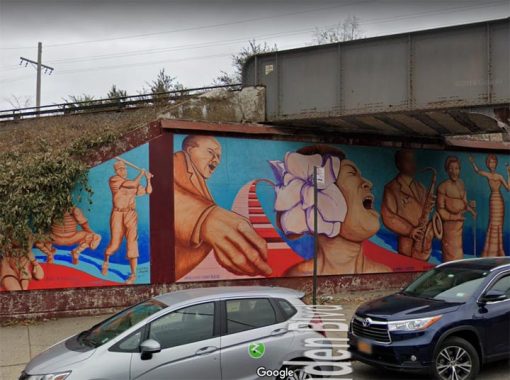
Mural depicting famed residents at Addisleigh Park at the St. Albans LIRR station at Linden Boulevard.

At Linden Boulevard and 190th Street in St. Albans, I spotted a metal framework above a brick building on the NW corner. I immediately suspected….
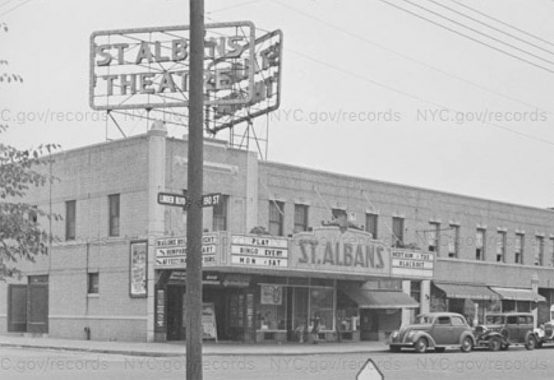
…that this could be a former theater, and I was correct. Cinematreasures is unsure when it opened and closed (this is a 1940 photo) but in the comments, it says that Gary “US” Bonds (“Quarter to Three,” “This Little Girl”) played the theater in the 1960s.
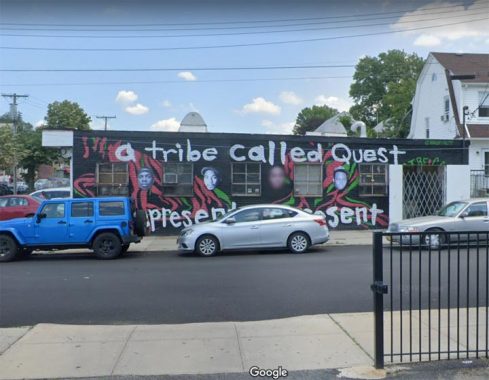

A Tribe Called Quest was a rap/hip hop group formed in St. Albans by Jonathan “Q-Tip” Davis, Ali Shaheed Muhammad and Malik “Phife Dawg” Taylor and active from 1985-2017, recording two #1 albums along the way.
“[W]ithout question the most intelligent, artistic rap group during the 1990s”, further stating that the group “jump-started and perfected the hip-hop alternative to hardcore and gangsta rap.” Music Citic John Bush at allmusic.com. After Phife Dawg‘s death in 2016, the corner of Linden Boulevard and 192nd Street was subnamed for him and a mural celebrating the group was painted on the side of Nu-Clear Laundromat.
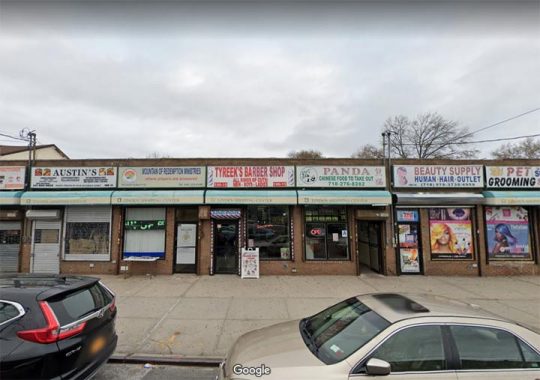
Storefront sampler, Linden Boulevard between 196th and 197th Street.
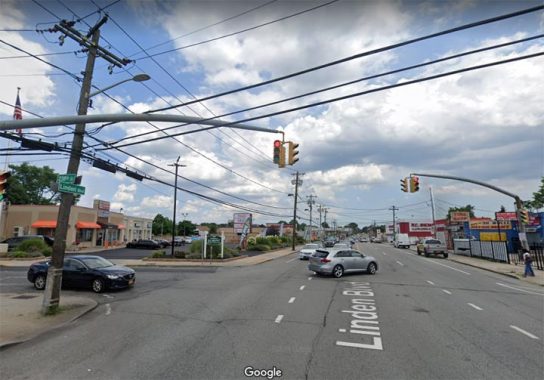
Just past Laurelton Parkway, Linden Boulevard roars out of the undefended city line and into Elmont in Nassau County. However, the NYC street numbering and house numbering system continues merrily along for a short run, as here at 238th Street.
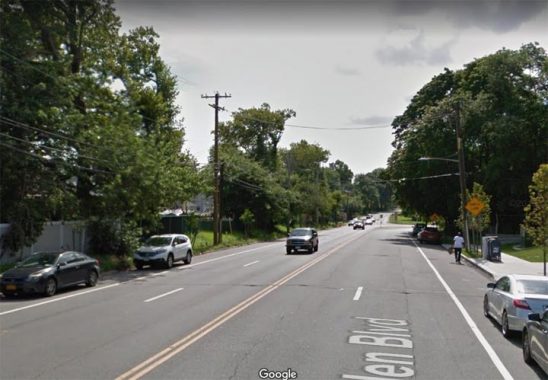
Further into Elmont, Linden Boulevard takes on amore suburban cast.
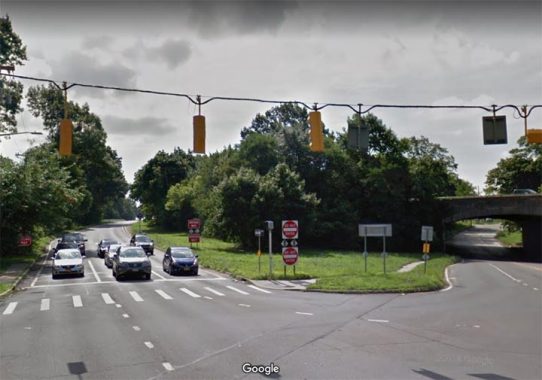
After 12.3 miles heading east, Linden Boulevard ends at the Southern State Parkway. The roadway on the left is a parkway off ramp, while the right roadway becomes Central Avenue, which runs south toward Valley Stream.
Check out the ForgottenBook, take a look at the gift shop, and as always, “comment…as you see fit.”
5/26/20

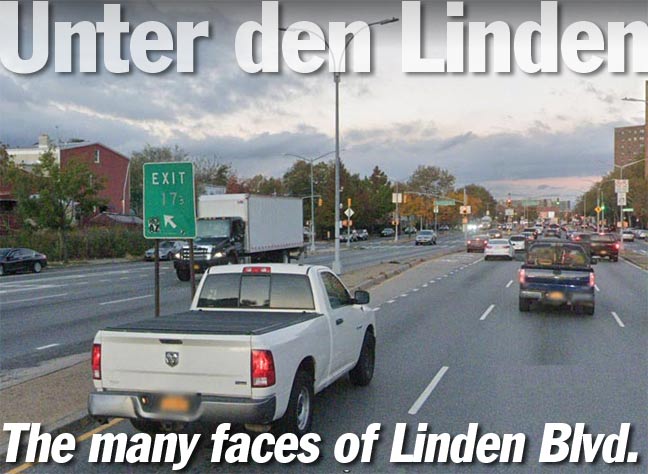
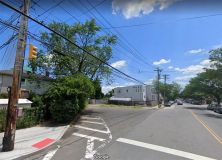
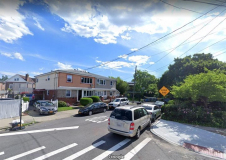
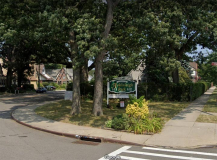
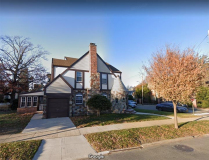
22 comments
Actually some trains on the 4 and 2 lines use this yard for servicing/storage. How do I know this? My daughter and son-in-law are both train operators
“Foch Boulevard is the only road in New York named after a French World War I commander.”
And there certainly aren’t any roads named after a French World War II commander, given how the country performed in that war.
If you ever read a story set in Britain and come across a reference to lime trees, it does not mean that global warming has made the British climate warm enough for citrus. The British sometimes, and confusingly, call linden trees lime trees. And in parts of the US they’re often called basswoods.
And to add a little confusion – an old term for British Navy sailors was “limeys,” because in the days before modern ships the men were given lime juice on long voyages to prevent scurvy, a vitamin deficiency disease caused from lack of vitamin C.
My research on Linden Boulevard (and a little on Willmohr St.):
Named for Linden Terrace, a 480-lot Flatbush real estate development subdivided in 1868 to capitalize upon the popularity of property near Prospect Park; the subdivision was bounded by Martense Street on the south and the now-closed Ridgewood Avenue to the north, and ran east from Flatbush Avenue to Canarsie Avenue. (now closed, was slightly to the east of Brooklyn Avenue)
As Linden Avenue, it was extended east to East 98th Street by the Kings County Town Survey Commission, which between 1869 and 1874 laid out the street grids in the Towns of Flatbush, Flatlands, Gravesend, New Lots and New Utrecht. At some point landscaped center malls were constructed between Bedford Ave. and Kings Hwy. The section between Remsen Avenue and East 98th Street was changed (for continuity) to Newport Street circa 1903; this was subsequently renamed as Willmohr Street on June 6, 1938, in memory of Pvt. William Mohr, killed in action during World War I.
In 1924 the city Board of Estimate approved the improvement and extension of Linden Avenue to connect with Conduit Boulevard and points east on Long Island. The landscaped malls between Bedford Avenue and Kings Highway were removed in favor of roadway. To be called Linden Boulevard, it would be extended east using both existing and new right-of-way into Queens.
There is a Foch Ave. in South Beach S.I. It parallels Olympia Blvd which you covered years ago.
I remember going on Linden Blvv to visit relatives 8n Lynbrook L I.back in the 1950s when my father had a commercial van that was barred from the Belt Parkway. What sticks in my mind is driving past farms with cultivated rows of vegetables and also in a few places, goats! I have heard tell that there was a dairy farm out there, too but did not see any cows.
I knew a “middle age” gentleman in the late 90s. He’d spent his entire life in ENY and seemed to have nothing but fond memories. When he referred to Linden, he would always call it”good ole nanny goat road!”. I loved that, I couldn’t imagine busy Linden with farms. It wasn’t until FNY did a page on the soggy area behind Lindenwood, that I could picture the area being rural.
Regarding the Peconic peculiarity: I have no particular explanation for why it happened but if you consult a handy copy of the 1913 E. Belcher Hyde atlas for westerly Jamaica you will notice that there a good number of streets — the majority only planned at the time — that carried the names of what seems to be rivers or other bodies of water. Maybe it was decided by city planners; maybe it was the choice of local developers of the area. Maybe it was a play off the already locally known Hawtree Creek. Or maybe inspired by the nearby Jamaica Bay. And, there was already an Ocean Avenue mapped. Basically, almost any street or avenue that existed at the time — or was planned for the future — bounded by Liberty Avenue, Rockaway Boulevard and Van Wyck Avenue that was not a direct extension of an existing Ozone Park/Richmond Hill street got a “water body” name. Some of these north-south streets that were to continue south of Rockaway Boulevard into Aqueduct (South Ozone Park) and there were some new names that don’t appear above Rockaway Boulevard. Many of these streets form an alphabetical sequencing. Maybe this is something Sergey would like to dig into…
Addendum: It looks like this naming convention was employed — or planned to be employed — below Liberty Avenue between modern day 79th Street through 87th Street. Some of the planned names would start more southerly than others due to the cemeteries and where you were in relation to the Sutter Avenue/Pitkin Avenue crossing.
Here are some old Linden Blvd. photos from Old NYC Photos website (formerly on the Brooklyn-Pix website):
East New York:
https://oldnycphotos.com/products/georgia-avenue-looking-north-to-linden-boulevard-1934
https://oldnycphotos.com/products/linden-boulevard-looking-west-to-alabama-avenue-1934
https://oldnycphotos.com/products/linden-boulevard-east-to-georgia-avenue-1934
East Flatbush: (note the median)
https://oldnycphotos.com/products/linden-avenue-boulevard-east-from-albany-avenue-1924
https://oldnycphotos.com/products/linden-avenue-boulevard-west-from-utica-avenue-january-21-1924 (in the distance on the left is my old elementary school PS 135)
https://oldnycphotos.com/products/linden-boulevard-looking-west-at-kings-highway-1924
https://oldnycphotos.com/products/linden-boulevard-looking-east-from-east-34th-street-1940
Thought I caught somewhere that Foch is pronounced Fosh but can’t seem to confirm that. Or is it a hard “k” pronunciation?
The talk of extending the #3 train south to Stanley Avenue comes from a March 1968 report issued by the brand-new MTA. Entitled “A Program for Action,” it was a laundry list of transportation projects planned for the next decade or so, funded in part by a $2.5 billion bond issue that New York State voters approved in November 1967. One such project was to extend the #3 line on a surface right-of-way for three blocks beyond the current train yard limit at Stanley Avenue. The new terminus would be at Linwood Street and Flatlands Avenue.
A number of major subway proposals in the 1968 report were built, such as the 63rd Street Tunnel and its connections to the IND and BMT at 57th Street, the Second Avenue subway between 63rd and 96th Streets, and the Archer Avenue subway in Jamaica. The #3 train extension is still a proposal.
Considering that all of those completed proposals in the1968 report took an eternity to build, at comically hyper inflated costs, I rather doubt we’ll be seeing the southern extension of the 3 train anytime soon.
Along the way, be sure to see the Forgotten-NY pages on the murals of Brownsville Rec Center, then the rail yard of the #3 line a mile to the east, and in Queens the broken segments of Linden Blvd.
Ah yes…Linden Boulevard, a/k/a “The Road to Beth David”, which we schlepped on from Brooklyn to our family’s numerous burials & unveilings, replete with histrionics rivaling any Woody Allen movie: Shrieking widows threatening to jump into the grave of their suddenly “beloved” spouses, who, for the most part, they themselves drove them to; my mother complaining about shrub trimming mid-service; the deafening roar of jets taking off from nearby LaGuardia, passing directly overhead while the Rabbi eulogized; Aunts & cousinspointing out graves of relatives that passed away eons ago, wailing about how unfair it is that they’re no longer with us, despite the fact they’d be well past 150 years old…oh yes, what memories…
volunteered at United Community Center! Linden Blvd @ Van Siclen Avenue. 613, I think…
As to the last sentence of this article, “while the right roadway becomes Central Avenue, which runs south toward Valley Stream,” I would re-write as, “while Linden Boulevard continues to the right, but resuming its former name of Central Avenue, and running south toward Valley Stream.” As noted in the article, Central Avenue began at Merrick Road, at an intersection also including Smith Avenue (now obliterated north of Foch Boulevard). At its other end, Central Avenue ended at Rockaway Road (now known as Roosevelt Avenue) and Old Mill Road, at a now-obliterated intersection that was on Roosevelt Avenue in front of 202 Roosevelt Avenue.
I found a Central Avenue sign in Elmont years ago but it’s gone now.
According to road maps, there aren’t a lot of state route numbers that run through NYC or at least not in this day and age except for 9A, 24, 25, 25A, and 27.
I forgot about 440, which is in Staten Island as another state route number in NYC.
No picture of my first school, PS 135 on Linden Blvd and Schenectady
Does anyone remember a Trolly car barn which was still standing around 1951 which I believe was on the North side of linden???. Also at about the same time was there a subway terminal also to the north but perhaps a mile or two east of the trolly barn? Thanks everyone and STAY WELL! Mark